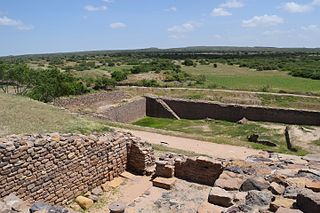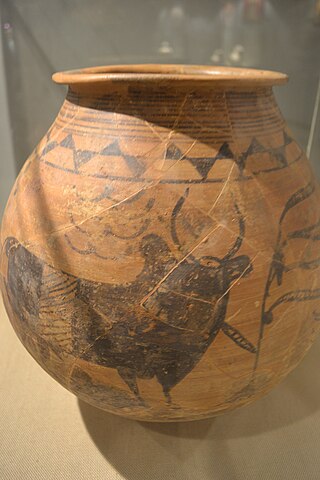
Mehrgarh is a Neolithic archaeological site situated on the Kacchi Plain of Balochistan in modern-day Pakistan. It is located near the Bolan Pass, to the west of the Indus River and between the modern-day Pakistani cities of Quetta, Kalat and Sibi. The site was discovered in 1974 by the French Archaeological Mission led by the French archaeologists Jean-François Jarrige and Catherine Jarrige. Mehrgarh was excavated continuously between 1974 and 1986, and again from 1997 to 2000. Archaeological material has been found in six mounds, and about 32,000 artifacts have been collected from the site. The earliest settlement at Mehrgarh, located in the northeast corner of the 495-acre (2.00 km2) site, was a small farming village dated between 7000 BCE and 5500 BCE.

The Indus Valley Civilisation (IVC), also known as the Indus Civilisation, was a Bronze Age civilisation in the northwestern regions of South Asia, lasting from 3300 BCE to 1300 BCE, and in its mature form from 2600 BCE to 1900 BCE. Together with ancient Egypt and Mesopotamia, it was one of three early civilisations of North Africa, Southwest Asia and South Asia, and of the three, the most widespread, its sites spanning an area including much of modern-day Pakistan, northwestern India and northeast Afghanistan. The civilisation flourished both in the alluvial plain of the Indus River, which flows through the length of Pakistan, and along a system of perennial monsoon-fed rivers that once coursed in the vicinity of the Ghaggar-Hakra, a seasonal river in northwest India and eastern Pakistan.

Rakhigarhi or Rakhi Garhi is a village and an archaeological site in the Hisar District of the northern Indian state of Haryana, situated about 150 km northwest of Delhi. It is located in the Ghaggar River plain, some 27 km from the seasonal Ghaggar river, and belonged to the Indus Valley civilisation, being part of the pre-Harappan, early Harappan, and the mature phase of the Indus Valley Civilisation.

Kalibangān is a town located at 29.47°N 74.13°E on the left or southern banks of the Ghaggar in Tehsil Pilibangān, between Suratgarh and Hanumangarh in Hanumangarh District, Rajasthan, India 205 km from Bikaner. It is also identified as being established in the triangle of land at the confluence of Drishadvati and Sarasvati Rivers. The prehistoric and pre-Mauryan character of Indus Valley civilization was first identified by Luigi Tessitori at this site. Kalibangan's excavation report was published in its entirety in 2003 by the Archaeological Survey of India, 34 years after the completion of excavations. The report concluded that Kalibangan was a major provincial capital of the Indus Valley Civilization. Kalibangan is distinguished by its unique fire altars and "world's earliest attested ploughed field". It is around 2900 BC that the region of Kalibangan developed into what can be considered a planned city.

Dholavira is an archaeological site at Khadirbet in Bhachau Taluka of Kutch District, in the state of Gujarat in western India, which has taken its name from a modern-day village 1 kilometre (0.62 mi) south of it. This village is 165 km (103 mi) from Radhanpur. Also known locally as Kotada timba, the site contains ruins of a city of the ancient Indus Valley civilization. Earthquakes have repeatedly affected Dholavira, including a particularly severe one around 2600 BCE.
Rangpur is an ancient archaeological site in Surendranagar district near Vanala on Saurashtra peninsula in Gujarat, western India. Lying on the tip between the Gulf of Khambhat and Gulf of Kutch, it belongs to the period of the Indus Valley civilization, and lies to the northwest of the larger site of Lothal. It is the type site for the Rangpur culture, a regional form of the late phase of the Indus Valley Civilization that existed in Gujarat during the 2nd millennium BCE.
Chanhu-daro is an archaeological site belonging to the Indus Valley civilization. The site is located 130 kilometers (81 mi) south of Mohenjo-daro, now in Sindh, Pakistan. The settlement was inhabited between 4000 and 1700 BCE, and is considered to have been a centre for manufacturing carnelian beads. This site is a group of three low mounds that excavations has shown were parts of a single settlement, approximately 7 hectares in size.

Shortugai (Shortughai), in Darqad District of northern Afghanistan, was a trading colony of the Indus Valley civilization established around 2000 BC on the Oxus river near the lapis lazuli mines. It is considered to be the northernmost settlement of the Indus Valley Civilization.

Nausharo is an archaeological site dating back to the Harappan period, located in Balochistan, Pakistan. The excavations were carried out between 1985 and 1996 by a French team of archaeologists, under the direction of Jean-François Jarrige. The other sites belonging to the same cluster are Mehrgarh and Pirak.

Harappan architecture is the architecture of the Bronze Age Indus Valley civilization, an ancient society of people who lived during c. 3300 BCE to 1300 BCE in the Indus Valley of modern-day Pakistan and India.
Gola Dhoro is an archaeological site belonging to Indus Valley civilization, situated at the head of the Gulf of Kutch, near Bagasara in Kutch district of Gujarat, India. The site contains a small fortified area of approximately 50x50 m with living quarters and manufacturing sites both inside and outside this area.
Kuntasi is an archaeological site which is identified as a port belonging to the Indus Valley civilization. This site is located on the right bank of Phulki River, about 2 km south-east of Kuntasi village and 30 km from Morbi in Maliya taluka of Morbi District in Gujarat state of India. It is five km inlandward from present shore line. It was first reported by P. P Pandya and later thoroughly explored by Y. M. Chitalwala. The excavations revealed two periods of occupation. Period I is assigned to the Mature Harappan phase and the Period II is assigned to the Late Harappan phase. This site was identified as a jetty and a manufacturing centre.

Mundigak is an archaeological site in Kandahar province in Afghanistan. During the Bronze Age, it was a center of the Helmand culture. It is situated approximately 55 km (34 mi) northwest of Kandahar near Shāh Maqsūd, on the upper drainage of the Kushk-i Nakhud River.
Kerala-no-dhoro(કેરળ-નો-ઢોરો), also known as Padri, is an archaeological site in Gujarat, India. Belonging to the Indus Valley civilisation, it is located on the southern coast of Kathiawar region. Dating from 3699-3792 B.C. known as Padri Culture or Early Harappan period a part of Sorath Harappan, Indus Valley culture.

Nindowari, also known as Nindo Damb, is a Kulli archaeological site, dating back to chalcolithic period, in Kalat District of Balochistan, Pakistan. Archaeological investigation of the site suggests that the Nindowari complex was occupied by the Harappans before the Kulli civilization arrived and that the Kulli culture was related to or possibly derived from the Harappan culture.
Periano Ghundai meaning "The Hill of Fairies" was an archaeological mound located in the Zhob district in Balochistan, Pakistan. The site is located 3 kilometres (1.9 mi) west of the town of Zhob. It was excavated in 1924 by Sir Aurel Stein and showed great resemblance to the Harappan culture.

Indus–Mesopotamia relations are thought to have developed during the second half of 3rd millennium BCE, until they came to a halt with the extinction of the Indus valley civilization after around 1900 BCE. Mesopotamia had already been an intermediary in the trade of lapis lazuli between the Indian subcontinent and Egypt since at least about 3200 BCE, in the context of Egypt-Mesopotamia relations.















